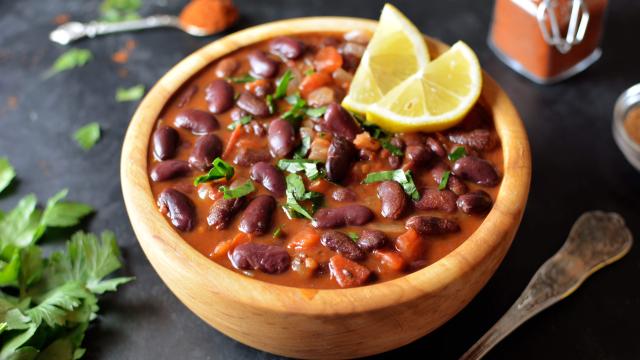Cooking dried beans isn’t quite as convenient as cracking open a can, but it does give you the chance to flavour them exactly how you like ‘em. One of my favourite additions is a strip of citrus zest. It may look puny swimming in a huge pot of beans, but don’t be fooled — even the tiniest piece flavours beans and their broth through-and-through with citrusy goodness.
To make a batch of your own, all you need is dried beans, a piece of citrus, and a peeler — not a microplane or box grater. Using a peeler is important because it gives you intact strips of rind, which are just plain better for a dish that cooks as long as dried beans. Citrus oils are super flavorful but extremely volatile, and zesting and grating spray most of them into the air, where they immediately evaporate. Whole strips of peel keep the oils safely contained, so all of their flavour extracts gradually as the beans cook. Plus, they’re easy to pluck out when the beans are done.
A word of advice: Take it easy on the zest. Since whole rind releases so much citrus oil as it cooks, you can definitely overdo it. One or two 1.5cm wide strips are all you need for 450 grams of dried beans — so if you’re cooking less than that, be sure to use even narrower strips. You can always add more to the next batch.
[referenced id=”820479″ url=”https://www.lifehacker.com.au/2018/01/seven-things-that-are-improved-by-a-bit-of-lemon-zest/” thumb=”https://www.gizmodo.com.au/wp-content/uploads/sites/4/2018/01/26/wxr53qlftmm8ycp2ztc9-300×169.jpg” title=”Use Lemon Zest To Drastically Improve These Foods ” excerpt=”Squeezing a bit of fresh lemon juice over a savoury dish adds a bit of brightness and helps balance out any overpowering richness, but there’s another portion of the lemon you should be sprinkling all over your culinary existence: the peel or, if you’re a regular barefoot count or countess,…”]
The only hard part is choosing a flavour combination, because the options are limitless. Lemon and orange peel are the most versatile, so they’re a great place to start. Most people have a strong preference for one or the other, so choose your favourite and use it to flavour any light-to-medium flavoured bean. Off the top of my head, chickpeas, cannellini or navy beans, limas, mayocobas, pintos, red lentils, black-eyed peas, cranberry beans, and pink beans are all perfect pairings. (If you can score a bag of the Rancho Gordo Royal Coronas, I am literally begging you to cook them with a couple strips of lemon zest. Begging!)
Lime and grapefruit are less foolproof, but they sing in the right application. Cooked lime peel has a specific flavour — earthier and noticeably more bitter than lemon or orange. For this reason, I think it works best with black beans, red kidneys, or any other variety with a thick, dark skin and intense flavour. Ultra-subtle grapefruit zest, which is underutilized in savoury cooking, works very well with pintos and pink beans. This inspiration comes from Matty Matheson’s refried beans, which are flavored with grapefruit juice and queso Oaxaca — a combination that sounds hideous but is actually so good.
I’m not being hyperbolic when I say refried beans made with pintos that were cooked with a strip of grapefruit zest will ruin you for other refried bean recipes. The subtle acidity barely registers as citrusy, let alone grapefruit-y — it’s just more interesting than your run-of-the-mill refried beans. I don’t know how it works, but it’s pure culinary magic.

Leave a Reply
You must be logged in to post a comment.